An investigator's observation skills, common sense, and research abilities are at
the heart of any investigation. But its the evidence gathered using equipment that makes up much of the final product
of an investigation. Witness statements, investigator experiences, and the background of a potentially haunted
site are extremely important...but people want to see or hear evidence. The equipment we used on this investigation
is shown and described below.
|
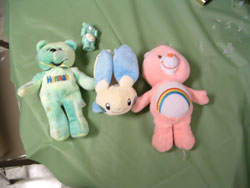
|
|
TRIGGER OBJECTS. The building that currently houses the Strawberry Hill Museum housed
the St. John's Children's Home (an orphanage) from 1919 until 1988. The fact that more than 3,000 children called
the building home over the 69 years it served as an orphange gave us the idea of using toys as trigger objects.
Three stuffed animals and one plastic figure were chosen. Four pieces of paper were taped firmly to the floor,
one toy was placed on each piece of paper, and the toys were traced around so that any movement of the toys could
be recorded. |
|

|
|
DR. GAUSS EMF DETECTOR. Hand-held, lightweight and durable, with an easy to read
scale (0-10 mG), and audio signal. It can also measure between 0.1 -1mG by holding in the button on the side of
the unit. A Great meter for demonstrating the presence of dangerous EMFs as well as for paranormal work. Requires
one 9V battery (not included). Calibrated at 50-60 Hz.
This EMF meter is an excellent introduction to ghost detection equipment....This meter measures the level of EMF
magnetic field radiation from power lines, computers, kitchen appliances, and more! The easy to read scale, unique
built-in audio signal and auto shut-off make it simple to use and a great way to find hidden sources of EMF frequency
magnetic fields. |
|

|
|
FUJIFILM FINEPIX 3800. This 3.2 megapixel digital camera films 10 frames a second
in video mode with sound (stored as MPEG 320x240 pixels). Here are some of the technical details:
The camera is capable of 3.34 Megapixel CCD (3.24 million effective pixels) with RGB filter, has precision retractable
Fujinon 6X optical zoom lens (F2.8/F4.8/F8.8), AVI video recording with sound, and sensitivity equivalent to ISO
100. It has shutter speeds of 1/2 to 1/1,500 sec. (combined with a mechanical shutter.) |
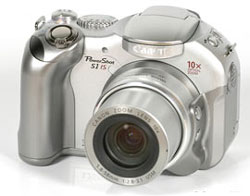 |
|
CANON POWERSHOT S1-IS. This digital camera has an extended zoom lens (10x). It can
take pictures with a resolution of 3.2 megapixels. It is well made and has an extensive range of features. The
flash unit has a maximum range of 3.8m when the zoom lens is not in use. The camera also has a "Movie"
Mode. Its possible to shoot at a high resolution of 640x480 at 30 frames per second. Lower resolutions and frames
speeds are possible as well. It can store up to an hour of movie footage or a maximum capacity of 1 gigabyte. It
also shoots time delay movies. |
|
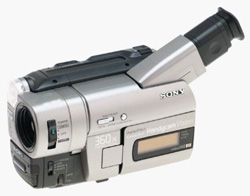
|
|
SONY CCD-TRV66 HI 8 VIDEO CAMERA. This camera has a lot of nice features. There's
a 20x optical/360x digital zoom and a digital photo mode, plus SteadyShot image stabilization, and Sony's exclusive
Hi8T XR Extended Resolution system to extend the luminance bandwidth for greater image detail and clarity. The
camera includes IR Night Shot technology at two different settings so that you have some choice about how it looks
depending on the level of darkness, etc. Dave Berg helped up import the analog images into digital images so that
we could share them on the website. |
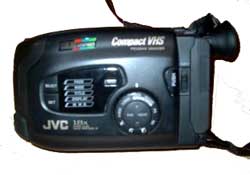 |
|
JVC GR-AX420 COMPACT CAMCORDER. This is an older camcorder, and records to mini-VHS
tapes. Its has Auto Mode Lock, Auto Mode Release, electronic fog filter, Variable -speed hyper zoom (18X), a date/time
setting, tape length settting, record mode setting, playback, editing features, and other features. |
|
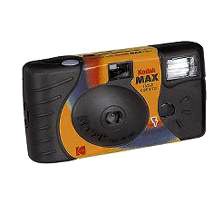
|
|
KODAK COLOR DISPOSABLE CAMERA. Cheap, easy to use, and disposable. These disposable
cameras are easy to stick in your pocket and pull out at a moments notice. The camera we used had 27 exposures
and 800 speed film. We developed our pictures directly to a CDR computer disk, and tucked away the negatives in
case we needed to review them later. |
|
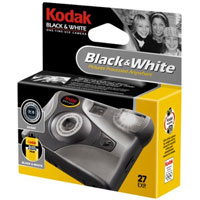
|
|
KODAK BLACK-AND-WHITE DISPOSABLE CAMERA. Cheap, easy to use, and disposable. These
disposable cameras are easy to stick in your pocket and pull out at a moments notice. The camera we used had 27
exposures and sharp black-and-white film. We developed our pictures directly to a CDR computer disk, and tucked
away the negatives in case we needed to review them later. |
|
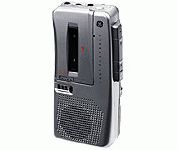
|
|
MICRO CASSETTE RECORDER. Two speed record. Automatic voice activatedrecording. Digital
tape counter. Four button cassette deckwith pause. Small contoured design. Headphone jack. |
 |
|
GE MICRO CASSETTE RECORDER. This image is not the exact model we were using. The
one we are using is an older model with VVA. The one in this picture is a slightly newer model. |
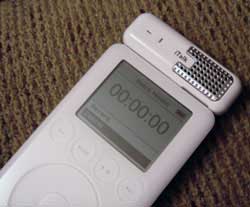 |
|
I-POD WITH I-TALK ATTACHMENT. The iPod has a 10 GB storage capacity on its hard drive,
a 1.98 inch screen, and a battery life of 10 hours. The iTalk is a voice recording attachment that allows the iPod
to act as an audio recorder. |
|
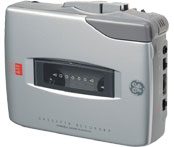
|
|
GE CASSETTE RECORDER (35366). We used two of these "mini-cassette recorders"
on the investigation. They use full sized cassette tapes, but the recording device itself is fairly small. This
model is light, compact and features quick push-button operation for both recording and playback along with an
Automatic Voice-Activated Recording mode. |
If you're curious about what sort of camera was used to capture any of our photos in these investigation reports,
just look at the name of the photo in its properties window. Those with "finepix" in their name were
taken with the FujiFilm Finepix 3800. Those with "digshawn" in their name were taken with the the Canon
Power-Shot S1-IS. Those with "color" in their name were taken with the color-film disposable camera shown
above. Those with "bw" in their name were taken with the black-and-white-film disposable camera shown
above. Any photos with "investigation" in their name were captured from a digital export of our analog
video from the Sony CCD-TRV66 Hi-8 Video Camera.
-Mark Srinson |











